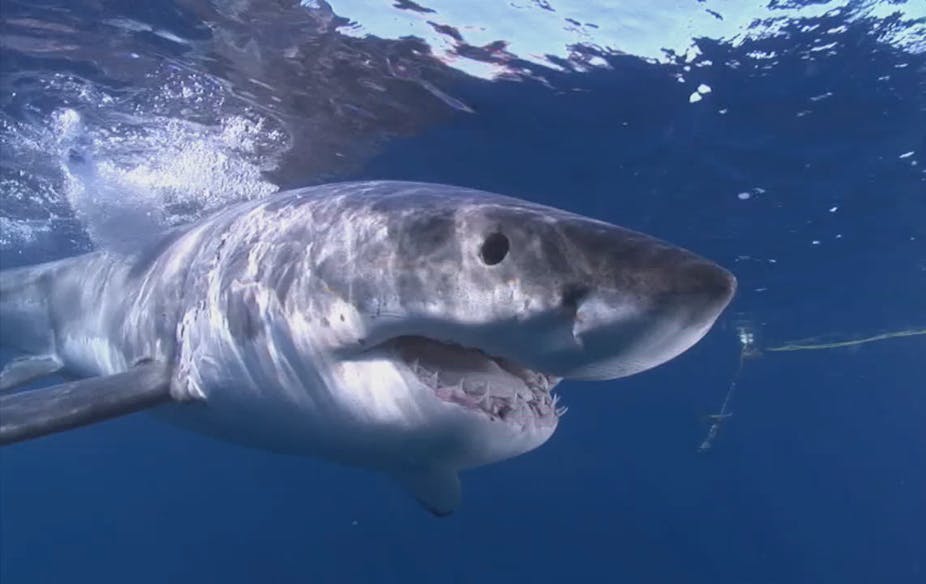An unprecedented cluster of white shark bite fatalities in Western Australia over the past decade has led the state government to enact a policy of culling large sharks in coastal waters off Perth and the state’s south-west.
The decision, which appears to have been made in the absence of good scientific evidence, has drawn national and international criticism. But equally, there is little information that the wider public can use to assess their personal risk of shark bite in WA waters.
Yet the evidence we do have about the factors that influence those risks suggests that culling sharks in the summer months, as the government is doing, is very unlikely to reduce them.
Why so many attacks now?
Statistics show us that even a spate of deaths like that in WA could be a simple quirk of fate. But assuming there are underlying factors at play, what might they be?
The fact that white sharks prey on humpback whales suggests that a key risk factor for shark bites is their attraction to the region during the annual humpback whale migration. In early winter, mature humpbacks travel north along the WA coast to the Kimberley region, before returning to Antarctica in late winter and spring. Mothers who have calved during this time lag a few months behind the main migration, resting from time to time in shallow coastal bays with their young.
My analysis – which, it must be stressed, is undergoing peer review at the time of writing – shows that shark bite frequency has grown exponentially between 1973 and 2013. During this time, humpback whale populations along the WA coast have grown at 10% per year. My work suggests that these two factors are closely linked.
The theory is bolstered by the fact that two-thirds of white shark bites occur during months when humpback whales are migrating through the local area. Roughly half of white shark bites on humans happen in spring, when humpback mothers and calves are migrating south.
Coupled with this circumstantial evidence is the fact that whale meat, usually obtained by scavenging dead whales rather than by direct hunting, contributes more than any other food by mass to the diet of large white sharks.
Has the shark population grown?
The true size of WA’s white shark population remains largely a mystery.
What we can say is that white sharks have been protected in most Australian states since the mid to late 1990s, meaning that the first group of white sharks that could have benefited from this protection will now be maturing to adulthood and increasingly preying upon marine mammals as part of their diet. Unfortunately, given the lack of reliable population data, we can’t say much more than that.
Meanwhile, it’s surprising to note that WA’s booming population over the past decade does not appear to be a significant factor in the rate of shark bites.
Participation in surf sports and diving have, if anything, declined slightly over the past decade.
What are the real risks?
In estimating the personal risk of white shark bite, the WA Department of Fisheries has identified water depth, choice of water activity, distance from shore, water temperature, and the presence of marine mammals as important risk factors.
Based on these factors, the risk of a fatal white shark bite varies hugely. My analysis shows that for Perth beachgoers bathing within 25 metres of shore during summer (which is outside the whales’ migration period), the risk is no more than 1 in 30 million per swim.
In contrast, for a diver more than 50 metres from shore, in cool waters more than 5 metres deep off WA’s southern coast, in the springtime when whales and their calves are close to shore, the risk may be as high as 1 in 15,000.
To put this in perspective, the risk of being bitten by a shark while swimming at a Perth beach in summer is about 50 times smaller than the risk of a serious or fatal recreational cycling injury in WA, and about 30 times smaller than the risk of being struck by lightning in Australia.

Reducing risk
Shark bite is an emotive topic, which evokes less-than-rational responses by both individuals and governments.
Based on what we know about the personal risk, the current summer shark culling policy in WA would appear to be unnecessary and at the time of writing is yet to catch or cull a large white shark.
Baiting during summer is very unlikely to reduce the risk of white shark bite during the higher-risk winter and spring months.
Although it may be expected that bite risk will increase as whale abundance continues to grow, for the foreseeable future, for the majority of bathers, it is likely that the risk of shark bite over WA’s summer will remain very low.
For those who choose to participate in higher-risk water activities such as diving, a better understanding of personal risk and the factors that influence shark bites could help people make informed choices about where, when and how to enjoy WA’s superb climate and its beautiful coastline.

